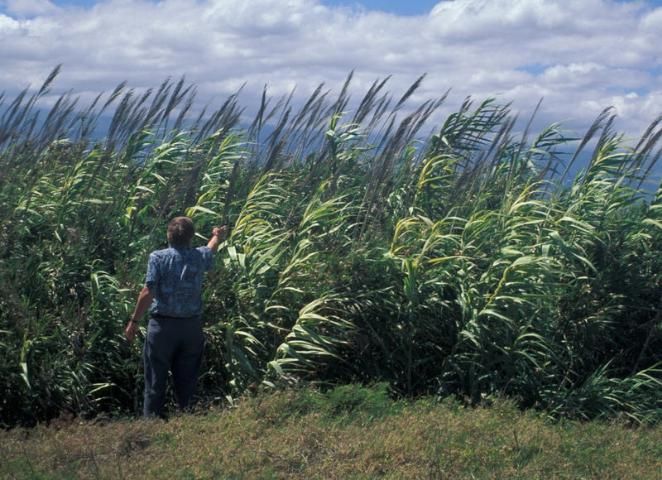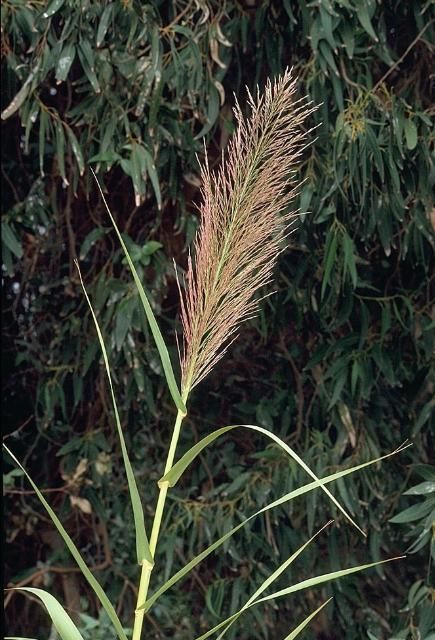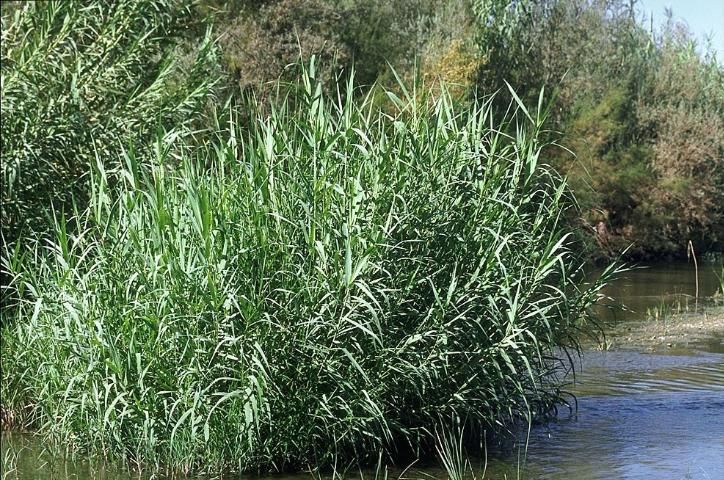Arundo donax (L.), also known as giant reed, is a non-native grass that was introduced to Florida over 100 years ago and is currently naturalized in at least 26 of the 67 Florida counties (Wunderlin and Hansen 2012). Giant reed is a difficult-to-control invasive grass causing severe economic losses in coastal and riparian environments in California and is spreading eastward to cause displacement of native communities and hydrologic problems in riparian sites in Nevada, Utah, Arizona, New Mexico, and Texas (Iverson 1994; DiTomaso et al. 2013). Hydric conditions in much of Florida provide suitable habitat, yet it is currently being permitted for bioenergy plantings in Florida because it is fast-growing and hardy (Lewandowski et al. 2003). Potential spread by high winds and flooding during tropical storms, high water consumption, and its significant height coupled with flammability may lead to adverse impacts to native species and habitats in Florida.

Credit: Forest and Kim Starr, US Geological Survey
Biology
Considered to have originated in Asia, giant reed has been cultivated for building materials and musical instruments for thousands of years. It has been introduced to temperate climates throughout the world, successfully adapting to many different environments (Perdue 1958; Bell 1997; Mariani et al. 2010). Giant reed is a tall, fast-growing, bamboo-like grass that under ideal conditions can reach a height of up to 30 feet and a stem diameter up to 1.5 inches (Perdue 1958; Bell 1997). Giant reed has high water use and grows best near water, yet established stands are resilient to drought (Bell 1977; Iverson 1994). The large alternate leaves resemble those of corn plants. Large, dense, plume-like flowers occur at the tips of stems. Plants are clumping, with many stems emerging from the root structure (Tucker 1990; Allred 2003). Giant reed forms dense rhizome mats that are normally shallow (0–6 inches) but can become more than three feet thick. The root masses, which store large amounts of carbohydrates, are fire-resistant and sprout easily, producing new plants (Else 1996; Bell 1997; Seawright 2009; Dudley 2011). Giant reed resembles the smaller plant common reed (Phragmites australis [(Cav.) Trin. ex Steud.], except that common reed spreads by above-ground runners (stolons) and typically forms dense continuous stands known as reed beds.

Credit: Joe DiTomaso, University of California, Davis
Propagation and spread of giant reed is vegetative, from sprouting rhizomes, and to a lesser extent from stem fragments. Stem fragments and rhizomes can remain viable for at least a month after separation from the parent plant (Wijte et al. 2005), and one study showed up to 30% viability 4 months after separation from the parent plant, even when subjected to desiccation (Boose and Holt 1999). Stems may also regenerate through layering, which occurs when the top of the stem is bent over and covered by soil, fostering root development and the establishment of a new plant (Boland 2006). Giant reed apparently does not produce viable seed in the United States (Else 1996; Dudley 2000), although viable seed production can occur in its native habitat (Bhanwra 1988; Johnson et al. 2006).
Invasiveness
Giant reed is tolerant of many diverse soil types and ecological conditions, including excessive salinity and varying conditions of drought or excessive moisture (Perdue 1958). The plant's tolerance to excessive moisture and salt may make it adaptive to Florida's coastal environments. Traits that make giant reed attractive for use as a bioenergy feed stock (it is large, fast-growing with efficient water use, and adaptive to a variety of environmental conditions) also foster potential invasiveness (Mack 2008). Because of the large above-ground size and clumping nature of the root masses, native species are displaced in proximity to giant reed (Bell 1997).
Some evidence suggests that giant reed does not spread quickly where there is little disturbance, other than downstream movement in riparian areas (Else 1996). However, it has become a management problem in areas where there was disturbance by machinery, storms, or strong flood events (Boland 2008). Because giant reed reproduces from pieces of stem or rhizomes, spread by grading equipment or mowers is a concern.

Credit: Joe DiTomaso, University of California, Davis
Control Methods
Biological
Four different insect types are being considered for biological control of giant reed. One of the four, the wasp Tetramesa romana (Walker), was approved for release by the US Department of Agriculture in 2009 (Seawright 2009). However, several insect species that show promise for controlling giant reed are only effective after stands have been cut and new growth that is more vulnerable to the insects has emerged (Mack 2008). This approach is labor intensive and the cost-effectiveness has not been determined. The aforementioned wasp and a scale insect being considered for biological control would most likely be dispersed by aircraft, an application method that would mitigate the potential spread of rhizomes and stem segments (Seawright 2009).
Mechanical Removal and Fire
Mechanical removal involves collecting and destroying the stems and all below-ground rhizomes, which is labor and machinery intensive. Any rhizomes or pieces of stems that are missed may re-sprout, reducing the effectiveness of the approach (Boland 2008). Mechanical removal is prohibitively expensive except on small areas, with costs reaching $8,100 per acre (Lawson et al. 2005). In addition, in cases where natural vegetation conservation or erosion potential are of concern, it is often desirable to leave the ground undisturbed.
Fire alone cannot be used to control giant reed, because it has little effect on the below-ground rhizomes and may have adverse effects on the native vegetation, providing an advantage for the fast-growing Arundo as the site re-vegetates (Bell 1997). Fire may play a useful role though, as a cost-effective means to remove accumulated above-ground mass and promote new growth in advance of herbicide treatment.
Herbicides
Operational experience in direct control of giant reed with herbicides dictates that established stands require multiple treatments and continued monitoring for sprouting rhizomes. Herbicide treatments following mechanical cutting are the most effective way of eradicating giant reed. The action of herbicides is improved by first cutting the stems near ground line and then spraying the re-sprouting stems when they are about three to four feet tall. Broadcast foliar sprays using glyphosate herbicide at the rate of 2 to 4.5 lb acid equivalent per acre (ae/Ac, a measure of the amount of active ingredient applied) provide effective control during periods of active growth (DiTomaso et al. 2013). When treating individual reed clumps, amounts of spray solution applied per acre will vary by rootstock density. For spot-spraying scattered giant reed clumps, mixtures using 3–5% glyphosate product (containing 41% active ingredient) in water provide effective control (Bell 1997; Spencer et al. 2008). However, a second application may be required to control surviving rootstocks (Garland 2003). Keep in mind that glyphosate may cause injury to other plants that are sprayed and in areas adjacent to water a glyphosate product approved for aquatic use, such as Rodeo®, must be used.
Imazapyr herbicide applied at 0.5 to 1.0 lb ae/Ac is also effective for giant reed control (Bell 2011). The imazapyr concentration in available products varies, as do amounts of spray solution applied per acre, but at a typical 30 gallons per acre spray volume, these per-acre rates equate to 0.4 to 0.8% Arsenal® or 0.8 to 1.6% Chopper® product in water. Keep in mind that imazapyr is a persistent herbicide, which, unlike glyphosate, may be absorbed from the soil by roots extending into the treated area. It may be particularly injurious to trees. A lower rate of imazapyr mixed with glyphosate (0.25 lb ae imazapyr plus 1.0 lb ae glyphosate per acre) can provide comparable or better control (Bell 2011). Using this combination of herbicides can reduce costs and the amount of soil residual herbicide, compared to using imazapyr alone. The combination also provides two herbicide modes of action, reducing the likelihood of herbicide resistance.
Invasive Potential of Bioenergy Plantings
Although this potentially invasive plant has not been problematic in Florida to date, recent permitting of its planting for bioenergy feed stock may increase the risk of naturalization into plant communities of southeastern states (Loewenstein 2005). Biofuel crops introduced outside of their native range can potentially escape from cultivation and invade unmanaged habitats (Raghu et al. 2006; Barney and DiTomaso 2008; Buddenhagen et al. 2009). Many authors have advised that a precautionary approach should be the basis for bioenergy policies to minimize the negative impacts of exotic plants. (Chimera et al. 2010; Davis et al. 2010; Witt 2010; McCormick and Howard 2013). While a precautionary approach is attractive from an ecological perspective, management of invasive species in the United States has typically focused on controlling existing invaders rather than preventing new invasions (Finnoff et al. 2007). Uncertainty remains about how to manage the potential invasiveness of biofuel crops such as giant reed without harming the economic interests of stakeholders.
Literature Cited
Allred, K.W. 2003. Arundo. P. 11 In: Flora of North America North of Mexico. Vol. 25. Flora of North America Editorial Committee (ed.), Oxford University Press, New York.
Barney, J.N., and J.M. DiTomaso. 2008. "Nonnative species and bioenergy: Are we cultivating the next invader?" BioScience 58:1–7.
Bell, C.E. 2011. "Giant reed (Arundo donax L.) response to glyphosate and imazapyr." Journal of Aquatic Plant Management 49:111–113.
Bell, G. P. 1997. "Ecology and management of Arundo donax, and approaches to riparian habitat restoration in Southern California." In: Plant Invasion: Studies from North America and Europe. J.H. Brock, M. Wade, P. Pysek and D. Green, eds. Leiden, the Netherlands: Backhuys, pp. 104–114. Accessed June 24, 2022 at: https://water.ca.gov/LegacyFiles/irwm/grants/docs/Archives/Prop84/Submitted_Applications/P84_Round2_Implementation/County%20of%20Ventura%20(201312340014)/Attachment%208%20(cont)%20-%20Att8_IG2_BenCost_6of7.pdf
Bhanwra, R.K. 1988. "Embryology in relation to systematics of Gramineae." Annals of Botany II. 62:215–233.
Boland, J.M. 2006. "The importance of layering in the rapid spread of Arundo donax (giant reed)." Madroño 53(4):303–12.
Boland, J. M. 2008. "The roles of floods and bulldozers in the break-up and dispersal of Arundo donax (giant reed)." Madroño 55(3), 216–222.
Boose, A.B., and J.S. Holt. 1999. "Environmental effects on asexual reproduction in Arundo donax." Weed Research 39:117–127.
Buddenhagen, C.E., C. Chimera, and P. Clifford. 2009. "Assessing biofuel crop invasiveness: A case study." PLoS ONE 4:35261.
Chimera, C.C., C.E. Buddenhagen, and P.M. Clifford. 2010. "Biofuels: the risks and dangers of introducing invasive species." Biofuels 1:785–596.
Davis, A.S., R.D. Cousens, J. Hill, R.N. Mack, D. Simberloff, and S. Raghu. 2010. "Screening bioenergy feedstock crops to mitigate invasion risk." Frontiers Ecol Environ 8:533–539.
DiTomaso, J.M., G.B. Kyser, et al. 2013. Weed Control in Natural Areas in the Western United States. Weed Research and Information Center, University of California, Davis, CA. 544 pp.
Dudley, T.L. 2011. Global Invasive Species Database. Arundo donax. Invasive Species Specialist Group (ISSG) of the World Conservation Union. Accessed February 6, 2023 at: http://www.iucngisd.org/gisd/speciesname/Arundo+donax
Dudley, T.L. 2000. Arundo donax. Pp. 53–58 In: Invasive plants in California's wildlands. Bossard, C.C., J.M. Randall and M.C. Hoshovsky (eds.). University of California Press, Berkeley, CA.
Else, J. A. 1996. Post-flood establishment of native woody species and an exotic, Arundo donax, in a Southern California riparian system. Master's thesis. San Diego State University, San Diego, CA. Accessed June 24, 2022 at: http://teamarundo.org/ecology_impacts/giessow_j_thesis.pdf
Finnoff, D., J.F. Shogren, B. Leung and D. Lodge. 2007. "Take a risk: Preferring prevention over control of biological invaders." Ecol Econ 62:216–222.
Garland, M.A. 2003. Arundo donax risk assessment. Florida Department of Agriculture and Consumer Services, Division of Plant Industry memorandum. Gainesville, FL. 8 p. [To obtain copies contact: patti.anderson@freshfromflorida.com].
Iverson, M. E. 1994. The impact of Arundo donax on water resources. Arundo donax Workshop Proceedings. November, 1993, Ontario, CA. p 19–25. Accessed June 24, 2022 at: https://www.cal-ipc.org/docs/resources/news/pdf/newsletters879.pdf#page=10
Johnson, M., T. Dudley, and C. Burns. 2006. "Seed production in Arundo donax?" Cal-IPC News. 14:12–13. Accessed June 24, 2022 at: https://www.cal-ipc.org/docs/resources/news/pdf/Fall2006.pdf#page=12
Lawson, D. M., J. A. Giessow, and J. H. Giessow. 2005. "The Santa Margarita River Arundo donax control project: development of methods and plant community response." Pp. 229–244 In: USDA Forest Service Gen. Tech. Rep. PSW-GTR-195. Albany, CA.
Lewandowski, I., J. M. O. Scurlock, E. Lindvall and M. Christou. 2003. "The development and current status of perennial rhizomatous grasses as energy crops in the US and Europe." Biomass and Bioenergy 25:335–361.
Loewenstein, N. 2005. "Review of giant reed (Arundo donax)." Alabama Invasive Plant Council. Accessed June 24, 2022 at: https://www.se-eppc.org/alabama/greedstatement.pdf
Mariani, C., R. Cabrini, A. Danin, P. Piffanelli, A. Fricano, S. Gomarasca, M. Dicandilo F. Grassi, and C. Soave. 2010. "Origin, diffusion and reproduction of the giant reed (Arundo donax L.): a promising weedy energy crop." Annals of Applied Biology 157 (2):191–202.
Mack, R.N. 2008. "Evaluating the credits and debits of a proposed biofuel species: giant reed (Arundo donax)." Weed Science 56: 883–888.
McCormick, N. and G. Howard. 2013. "Beating back biofuel crop invasions: Guidelines on managing the invasion risk of biofuel developments." Renew Energ 49:263–266.
Perdue, R.E. 1958. "Arundo donax: source of musical reeds and industrial cellulose." Economic Botany 12:368–404.
Seawright, E. K. 2009. Select economic implications for the biological control of Arundo donax along the Rio Grande. MS Thesis, Texas A&M University. Accessed June 24, 2022 at: https://oaktrust.library.tamu.edu/bitstream/handle/1969.1/90521/TR-358%20Economic%20Implications%20of%20Biological%20Control%20of%20Arundo%20donax%20in%20Rio%20Grande%20Basin%2011-13-09.pdf
Spencer, D. F., W. Tan, P.S. Liow, G.G. Ksander, L.C. Whitehand, S. Weaver, J. Olson, and M. Newhouser. 2008. "Evaluation of glyphosate for managing giant reed (Arundo donax L.)" Invasive Plant Science and Management 1:248–254.
Raghu S., R.C. Anderson, C.C. Daehle, A.S. Davis, R.N. Wiedenmann, D. Simberloff, and R.N. Mack. 2006. "Adding biofuels to the invasive species fire?" Science 313:1742.
Tucker, G. C. 1990. "The genera of Arundinoideae (Gramineae) in the southeastern United States." Journal of the Arnold Arboretum 71:145–177.
Wijte, A.H. B. M., T. Mizutani, E.R. Motamed, M.L. Merryfield, D.E. Miller and D.E. Alexander. 2005. "Temperature and endogenous factors cause seasonal patterns in rooting by stem fragments of the invasive giant reed, Arundo donax (Poaceae)." International Journal of Plant Science 166(3):507–517.
Witt, A.B.R. 2010. "Biofuels and invasive species from an African perspective—a review." GCB Bioenerg 2:321–329.
Wunderlin, R. P., and B.F. Hansen. 2012. Atlas of Florida vascular plants. Institute for Systematic Botany, University of South Florida, Tampa, FL. Accessed June 24, 2022 at: https://florida.plantatlas.usf.edu